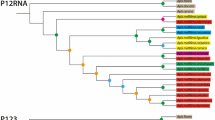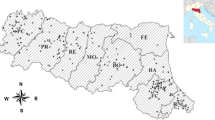Abstract
AFRICAN honey bees have populated much of South and Central America and will soon enter the United States. The mechanism by which they have spread is controversial. Africanization may be largely the result of paternal gene flow into extant European populations or, alternatively, of maternal migration of feral swarms that have maintained an African genetic integrity. We have been using both mitochondrial and nuclear DNA restriction fragment length polymorphisms to follow the population dynamics between European and African bees. In earlier reports, we suggested that if African honey bees had distinctive mitochondrial (mt) DNA, then it could potentially distinguish the relative contributions of swarming and mating to the Africanization process1,2. Because mtDNA is maternally inherited, it would not be transmitted by mating drones and only transported by queens accompanying swarms. Furthermore, the presence of African mtDNA would reflect unbroken maternal lineages from the original bees introduced from Africa. The value of mtDNA for population studies in general has been reviewed recently3,4. Here we report that 19 feral swarms, randomly caught in Mexico, all carried African mtDNA. Thus, the migrating force of the African honey bee in the American tropics consists of continuous African maternal lineages spreading as swarms. The mating of African drones to European queens seems to contribute little to African bee migration.
This is a preview of subscription content, access via your institution
Access options
Subscribe to this journal
Receive 51 print issues and online access
$199.00 per year
only $3.90 per issue
Buy this article
- Purchase on SpringerLink
- Instant access to full article PDF
Prices may be subject to local taxes which are calculated during checkout
Similar content being viewed by others
References
Hall, H. G. Proc. natn. Acad. Sci., U.S.A. 83, 4874–4877 (1986).
Hall, H. G. in Africanized Honey Bees and Bee Mites (eds Needham, G. R., Page, R. E. Jr, Delfinado-Baker, M. & Bowman, C. E.) 287–293 (Ellis Horwood, Chichester, 1988).
Avise, J. C. et al. A. Rev. ecol. Syst. 18, 489–522 (1987).
Moritz, C., Dowling, T. E. & Brown, W. M. A. Rev. ecol. Syst. 18, 269–292 (1987).
Ruttner, F. Proc. 25th Int. Congr. Apimondia. 325–344 (1975).
Kerr, W. E. S. Afr. Bee J. 39, 3–5 (1967).
Michener, C. D. et al. Final Report: Committee on the African Honey Bee (Natn, Acad. Sci. USA, Washington DC, 1972).
Michener, C. D. A. Rev. Entomol. 20, 399–416 (1975).
Taylor, O. R. Bull. Entomol. Soc. Amer. 31, 14–24 (1985).
McDowell, R. The Africanized Honey Bee in the United States: What Will Happen to the U.S. Beekeeping industry? Agricultural Economic Report No. 519 (US Department of Agriculture, Washington DC, 1984).
Taylor, O. R. A. Internal Med. 104, 267–268 (1986).
Boreham, M. M. & Roubik, D. W. Bull. Entomol. Soc. Amer. 33, 34–38 (1987).
Taylor, O. R. in Africanized Honey Bees and Bee Mites (eds Needham, G. R., Page, R. E. Jr, Delfinado-Baker, M. & Bowman, C. E.) 29–41 (Ellis Horwood, Chichester, 1988).
Rinderer, T. E. Bull. Entomol. Soc. Amer. 32, 222–227 (1986).
Erickson, E. H. Jr.,, Erickson, B. J. & Young, A. M. Gleanings Bee Cult. 114, 456–459 (1986).
Rinderer, T. E., Collins, A. M., Hellmich, R. L. II, & Danka, R. G. Apidologie 18, 61–68 (1987).
Rinderer, T. E., Hellmich, R. L. II, Danka, R. G. & Collins, A. M. Science 228, 1119–1121 (1985).
Collins, A. M. in Africanized Honey Bees and Bee Mites (eds Needham, G. R., Page, R. E. Jr, Delfinado-Baker, M. & Bowman, C. E.) 110–117 (Ellis Horwood, Chichester, 1988).
Sylvester, H. A. J. Apicultural Res. 21, 93–97 (1982).
Daly, H. V. in Africanizer Honey Bees and Bee Mites (eds Needham, G. R., Page, R. E. Jr, Delfinado-Baker, M. & Bowman, C. E.) 245–249 (Ellis Horwood, Chichester, 1988).
Winston, M. L., Taylor, O. R. & Otis, G. W. Bee World 64, 12–21 (1983).
Smith, D. R. & Brown, W. M. Experentia 44, 257–260 (1988).
Moritz, R. F. A., Hawkins, C. F., Crozier, R. & Mackinlay, A. G. Experentia 42, 322–324 (1986).
Page, R. E. Jr, Erickson, E. H. Jr & Laidlaw, H. H. Jr Amer. Bee J. 122, 350–355 (1982).
Smith, D. R. & Brown, W. M. Nature, this issue.
Hall, H. G. Genetics, submitted.
Taylor, O. R. Amer. Bee J. 125, 586–587 (1985).
Takahata, N. & Slatkin, M. Proc. natn. Acad. Sci. U.S.A. 81, 1764–1767 (1984).
Lamb, T. & Avise, J. C. Proc. natn. Acad. Sci., U.S.A. 83, 2526–2530 (1986).
Marchant, A. D. Heredity 60, 39–46 (1988).
Taylor, O. R. Bee World 58, 19–30 (1977).
Harbo, J. R., Bolten, A. B., Rinderer, T. E. & Collins, A. M. J. Apicultural Res. 20, 156–159 (1981).
Liepins, A. & Hennen, S. Devl Biol. 57, 284–292 (1977).
Miller, S. G., Huettel, M. D., Davis, M.-T. B., Weber, E. H. & Weber, L. A. Molec. gen. Genet 203, 451–461 (1986).
Schmitz, U. K. & Michaelis, G. Theor. appl. Genet. 76, 565–569 (1988).
Latorre, A., Moya, A. & Ayala, F. J. Proc. natn. Acad. Sci., U.S.A. 83, 8649–8653 (1986).
Tapper, D. P., Van Etten, R. A. & Clayton, D. A. Meth. Enzymol. 97, 426–434 (1983).
Maniatis, T., Fritsch, E. F. & Sambrook, J. Molecular Cloning: A Laboratory Manual (Cold Spring Harbor Laboratory, New York, 1982).
Author information
Authors and Affiliations
Rights and permissions
About this article
Cite this article
Hall, H., Muralidharan, K. Evidence from mitochondrial DNA that African honey bees spread as continuous maternal lineages. Nature 339, 211–213 (1989). https://doi.org/10.1038/339211a0
Received:
Accepted:
Issue Date:
DOI: https://doi.org/10.1038/339211a0



